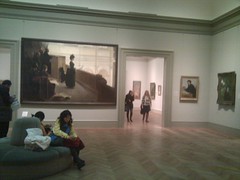Interpretive Exhibits Assignment 1
Cabinets of curiosities laid the foundation for the 2 main types of museum design. The 2 schools of museum design are what I call âdidacticâ and âgalleryâ.  The didactic and the gallery museums stem from the cabinets laying out and organizing their collections into logical groups. They differ in that gallery museums mostly stayed with Cabinets idea. Didactic museums grew out of worldâs fair mentality. When patrons would visit cabinets, they would draw conclusions on what they were seeing. When the worldâs fairs came around, governments and industry used amusement and explanation to sell themselves. They wanted to show new technologies and national treasures. Didactic museums embraced new technologies, because they have to keep up with changing history and explain it. Their collections grow based on expanding the museums knowledge base. Gallery museums have to keep up with their collection philosophy to stay relevant. At the end of the day itâs how museums contextualize their collections that make them special.
The fundamental differences between gallery and didactic museums lead to the difficulty in designing for both types of museum. You know your collection. In a gallery style museum you organize, make some logical sense, and exhibit. If your audience is not interested in the content, you have an unsuccessful museum. This is where taking from didactic style museums could enhance an audienceâs experience. Not everyone has the Mona Lisa or King Tutâs Tomb. Understanding an artistâs or architects process and context makes the piece more accessible. Though an artistâs job is to connect with an audience, many people do not have the vocabulary to realize why a certain piece is special. Most galleries have small placards explaining pieces, but graphics along with text could go a long way in explaining pieces. Context is key.
On the other side didactic museums can fall into the trap of being overly didactic and too focused on technology. Most science museums and natural history museums can contain similar items. There are many rocks and plenty of fauna to fill up a museum. In the end its how the story is told. In most gallery museums you categorize by date or artist, in didactic museums the contextual flow of an exhibit is important. Though difficult to provide a linear narrative to history in an exhibit, being able to make the viewer reference back to other parts of the exhibit is important. Technology can play a role in filling that gap. Technology can be gimmicky though. People can feel good design, but just because you have a room full of screens it does not make your exhibit good.
19th Century Galleries for Painting and Sculpture MET
This gallery is the quintessential art gallery. The art and the collection take center stage. The gallery opens up with a horizontal gallery connected to 3 vertical galleries. The horizontal gallery I felt had three themes, victory and mysticism, leisure, and women. The 3 vertical galleries seem to progress from left to right by time. The beginning of the exhibit showed a lot of photo realistic portraiture and scenery. Â Towards the back and emphasis was made to show the art nouveau movement, by recreating a room, but lacked more art work from the time.
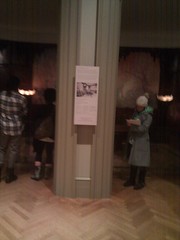
Some rooms were full of sceneries other full of portraits.
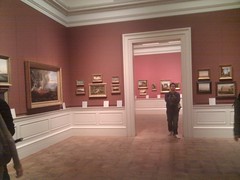
As you reach the center rooms and right most room, a heavy emphasis on Monet, Van Gogh, and artists like Pissaro are made. The organization the rooms are somewhat strange. Most of the Monet paintings are located in singular rooms, but the Van Gogh paintings are split between 2 rooms and are placed along the same wall. Though you can catch similar styles from peaking into rooms and looking, unless you happen to read the right sign, you might miss the history as to why. Some rooms are dimly lit to highlight sculpture but paints also placed in the rooms suffer from the low light.
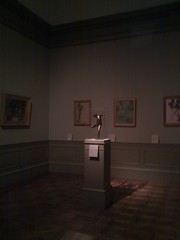
Rooms all very similar but vary in color. Reds, purples, tans, and whites line the walls. I tried to discern a pattern as to why certain rooms where colored that way but I was not able to figure out if there was.

The galleries definitely showed 19th century art. The art housed in the space is amazing. The issues I have with galleries is the following, I want to know more. If I am come to the gallery multiple times a year or even that one time, I would like context to what I am seeing. As I enter a room full or Monetâs I would like to know a general overview at what I am seeing. While the little placards are great, having something that explains the bigger picture would be nice. A good example is Toulouse-Lautrecâs Portrait of Henri Gabriel Ibels. In a sign it says the Ibels was a founder of Nabi brotherhood, which included Bonnard and Vuillard.
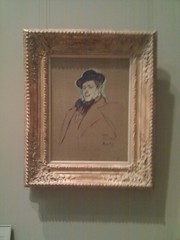
This gives in-site as to what inspired artists. The center area could used to give general context to rooms and paintings, which will let patrons make more connection with the work.
